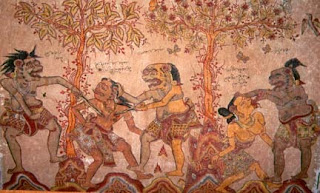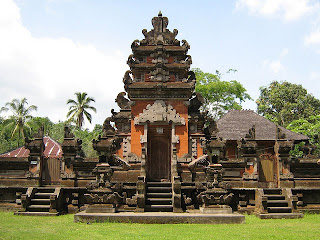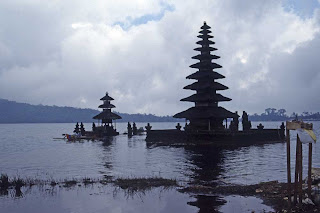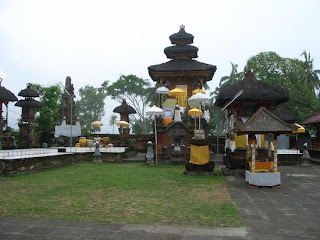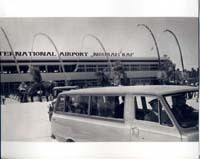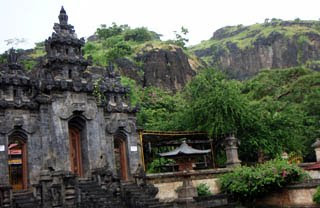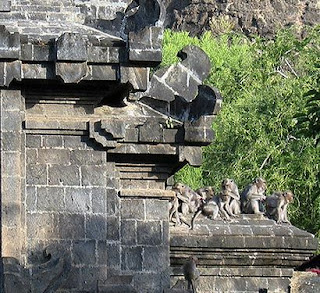There are the stories of the Painting at Kertagosa and Taman Gili :
1. Sutasoma Story
Sutasoma story can be seen at Taman Gili building on the panel of first, second, third and fourth from the top on the ceiling of the building. I read it starts from the top panels of the south, from left to right. This fragment narrating the journey of Sutasoma from Astina castle Mahameru into the mountains. In this course, there are many hurdles that must be faced, but with inner strength that is owned, Sutasoma managed to overcome all obstacles.
2. Pan Brayut
Pan Brayut story depicted in the fifth row from the top, on the ceiling Taman Gili. Meanwhile, the chronology of the story can be seen from the northeast corner to the south. This painting tells the life of Pan Brayut endowed with 18 children, so that almost no time to take care of everything else, except the care of children.
3. Palalintangan
Panel on Palalintangan, located on the bottom row of buildings ceilings Taman Gili. Palalintangan is understanding the influence of the stars in the sky to human birth. Here narrated the 35 kinds of human nature which vary by day of birth.
4. Ni Dyah Tantri
Ni Dyah Tantri story contained in the first panel (bottom) on the ceiling Kertagosa building, which starts from the panel flowed east to the south, west and north ends on panels. Ni Dyah Tantri story, tells of a girl named Ni Dyah Tantri who tried to eliminate the desire of a king to always marry the girl every day. Ni Dyah Tantri is a daughter of Maha Patih from king who likes women. As the Maha Patih every day decreed by the King to find a girl. For that Ni Dyat Tantri dare to sacrifice himself to help his father to accompany the king's wife. Because she's smart talk, every night Ni Dyah Tantri gave the story to the king so that his desire to marry a girl every day can be eliminated.
5. Bhima Swarga
The story of Bhima Swarga tells the journey Bhima (the second son of the Pandavas) to Yamaloka accompanied by his mother Kunti, his brothers (Yudhisthira, Arjuna, Nakula and Sadewa), to find her father, and stepmother Pandhu, Madrim. In Yamaloka, found a variety of events experienced by the soul (atma) in accordance with his deeds in the world. For example, people who like lying tongue is pulled, people who like adultery burned and so on. Whatever the obstacles it faces, but because of the spirit and determination that is owned, Bhima finally managed to obtain pure water (amrta) that can be used to redeem his father and his stepmother in Yamaloka.
6. Pelelindon
Pelelindon depicted on the fifth level of the bottom panels on the ceiling Kertagosa Hall building. Pelelindon story starts from the middle of panel north of the next in sequence to the east, south, west and back to the north panel.
1. Sutasoma Story
Sutasoma story can be seen at Taman Gili building on the panel of first, second, third and fourth from the top on the ceiling of the building. I read it starts from the top panels of the south, from left to right. This fragment narrating the journey of Sutasoma from Astina castle Mahameru into the mountains. In this course, there are many hurdles that must be faced, but with inner strength that is owned, Sutasoma managed to overcome all obstacles.
2. Pan Brayut
Pan Brayut story depicted in the fifth row from the top, on the ceiling Taman Gili. Meanwhile, the chronology of the story can be seen from the northeast corner to the south. This painting tells the life of Pan Brayut endowed with 18 children, so that almost no time to take care of everything else, except the care of children.
3. Palalintangan
Panel on Palalintangan, located on the bottom row of buildings ceilings Taman Gili. Palalintangan is understanding the influence of the stars in the sky to human birth. Here narrated the 35 kinds of human nature which vary by day of birth.
4. Ni Dyah Tantri
Ni Dyah Tantri story contained in the first panel (bottom) on the ceiling Kertagosa building, which starts from the panel flowed east to the south, west and north ends on panels. Ni Dyah Tantri story, tells of a girl named Ni Dyah Tantri who tried to eliminate the desire of a king to always marry the girl every day. Ni Dyah Tantri is a daughter of Maha Patih from king who likes women. As the Maha Patih every day decreed by the King to find a girl. For that Ni Dyat Tantri dare to sacrifice himself to help his father to accompany the king's wife. Because she's smart talk, every night Ni Dyah Tantri gave the story to the king so that his desire to marry a girl every day can be eliminated.
5. Bhima Swarga
The story of Bhima Swarga tells the journey Bhima (the second son of the Pandavas) to Yamaloka accompanied by his mother Kunti, his brothers (Yudhisthira, Arjuna, Nakula and Sadewa), to find her father, and stepmother Pandhu, Madrim. In Yamaloka, found a variety of events experienced by the soul (atma) in accordance with his deeds in the world. For example, people who like lying tongue is pulled, people who like adultery burned and so on. Whatever the obstacles it faces, but because of the spirit and determination that is owned, Bhima finally managed to obtain pure water (amrta) that can be used to redeem his father and his stepmother in Yamaloka.
6. Pelelindon
Pelelindon depicted on the fifth level of the bottom panels on the ceiling Kertagosa Hall building. Pelelindon story starts from the middle of panel north of the next in sequence to the east, south, west and back to the north panel.
